News
Unravelling the Mystery of Supernova Explosions
Takizawa Minako
Updated in April 2021
Koshiba Masatoshi and Kajita Takaaki, two recipients of the Nobel Prize in physics, both made significant contributions to the world-class neutrino observatories Kamiokande and Super Kamiokande. After an August 2020 upgrade, the Super Kamiokande facility is now exploring supernova explosions and the history of space. A talk with Nakahata Masayuki, a lecturer at the University of Tokyo and director of the Super Kamiokande observatory in Kamioka, Gifu.
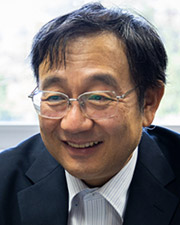
Nakahata Masayuki
Director of the Kamioka Observatory, operated by the University of Tokyo’s Institute for Cosmic Ray Research. Nakahata is also the director of the Super-Kamioka Nucleon Decay Experiment. Born in Matsumoto, Nagano, in 1959, Nakahata began studying the physical sciences at the University of Tokyo in 1978, earning his BS in 1982 and his MS in 1988. Nakahata also holds a doctorate in the physical sciences. A lecturer at the Institute for Cosmic Ray Research since 2003, Nakahata was appointed chief researcher at the Kavli Institute for the Physics and Mathematics of the Universe in 2007, before in 2014 becoming director of the Kamioka Observatory and the Super Kamiokande Group. Since 2015, Nakahata has served as deputy director of the Institute for Cosmic Ray Research. Awards include the Nishina Memorial Prize. Publications include Kieta taiyō nyūtorino no nazo o ou (Pursuing the Mystery of Vanishing Solar Neutrinos), and the third chapter in Kamiokande to nyūtorino (Kamiokande and Neutrinos).
From Philosopher’s Stone to Secrets of the Universe
John Maynard Keynes, the father of macroeconomics, once started a treatise with the unusual phrase: “It is with some diffidence that I try to speak to you . . . of Newton as he was himself.”
The essay, “Newton, the Man,” was an exposé on Isaac Newton, the founder of modern science. In 1936, some years before Keynes wrote his essay, a box containing Newton’s essays was put up for auction at Sotheby’s by a descendent of the Earl of Portsmouth. Keynes bought about half of the essays, including manuscripts on alchemy, which were dotted with coded references to “green lions” and “sordid whores.” Keynes wrote that he believed Newton had “one foot in the Middle Ages and one foot treading a path for modern science.”
In fact, Newton in the seventeenth century was looking for a “philosopher’s stone” that would change lead and other base metals into gold and make humankind immortal. Toward the end of his life, Newton invested much of his time and money in alchemy, and is said to have gone mad from mercury poisoning.
But just why did such an esteemed scientist become absorbed in research of the occult? After much consternation, scientific historians came to speculate that after discovering the laws of the universe that govern mass (the laws of universal gravitation), Newton tried to formulate a theory of matter. These historians surmise that Newton believed alchemy could lead him to the crux of that fundamental question, “what is matter made of?”
Newton was 300 years before his time, however: It was not until the twentieth century that nuclear physics, particle physics, and Big Bang Theory gave us the beginnings of an answer to Newton’s question. Only now have we finally accumulated sufficient knowledge, in the form of neutrino astronomy, to explore this mystery.
Japan’s Leading Neutrino Research
Many people have heard of the research on neutrinos performed by Koshiba Masatoshi and Kajita Takaaki, the two renowned Japanese Nobel Prize–winning physicists, or are at least familiar with their names. After successfully using the Kamiokande to observe the neutrinos emitted from an exploding supernova in 1987, chief researcher Koshiba was awarded the Nobel Prize for Physics in 2002. This recognition made waves impact in Japan, and led to the construction of the Super Kamiokande facility (or “Super-K”), 25 times larger, which went online in 1996. Kajita subsequently received a Nobel Prize in 2015 for his study of the vibrations that indicate neutrino mass. Japan’s neutrino research has thus made striking progress.
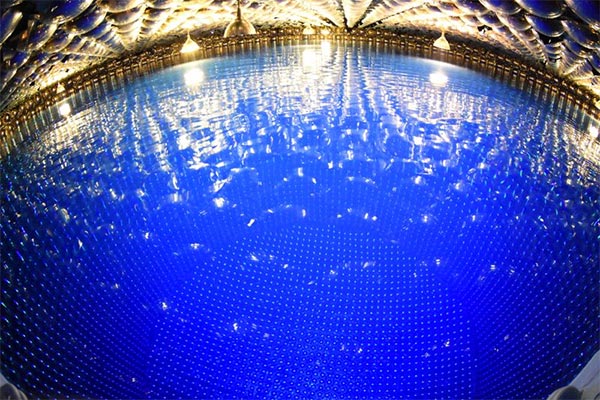
Neutrinos are one of the basic units of the matter that makes up the universe, and are known for being the most difficult to observe. For example neutrinos that reach earth are most likely to have been created in the sun. While each of us is struck by hundreds of trillions of these neutrinos every second, 99.999999999999999999999% (that’s 23 nines!) of them pass through us untouched. In fact, on average, only one neutrino every 50 to 100 years will actually collide with any of the atomic nuclei or electrons that make up our bodies. Any kind of reaction involving a neutrino is therefore inherently miraculous.
As Nakahata Masayuki, director of the Super Kamiokande and the Kamioka Observatory, explains, however, the 50,000 metric tons of ultrapure water in the Super Kamiokande is able to intercept around 20 neutrinos a day from the sun and around 10 from the atmosphere.
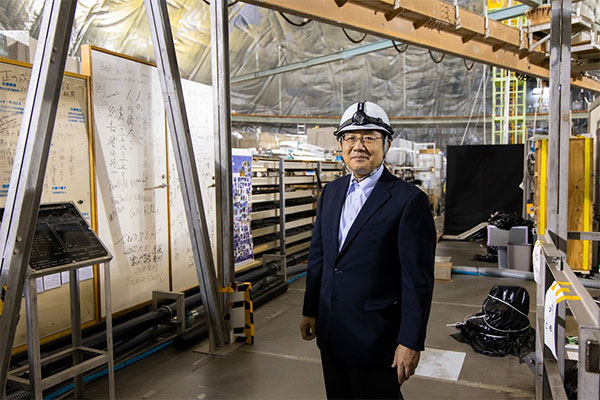
A Glimpse into the Furnaces of the Universe
So what can catching neutrinos tell us about space?
“First you need to know a little bit of the history of the universe. The universe came into existence 13.8 billion years ago with the Big Bang, which produced predominantly hydrogen and helium; the heavier elements were then created inside stars as a result of nuclear fusion and supernova explosions. Those elements heavier than iron, in particular gold and silver, are believed to have been synthesized instantaneously in the explosions of dying supernova—stars that are eight times more massive than our sun—and in the high-pressure environments created by neutron star mergers,” says Nakahata.
In other words, the “philosopher’s stone” that is able to synthesize gold was to be found not on earth but in supernova explosions and other “furnaces” of the universe.
Gravitational forces eventually cause elements scattered through the universe by such explosions to clump together, forming new stars, which ultimately reach the end of their lives and explode again. In other words, if you think of the lighter elements as high-pitched musical instruments and the heavier elements as low-pitched ones, you can say that every time a star dies and is reborn, it gains more heavy elements, thereby enriching the timbre of the universe.
It follows that the solar system, the earth, and even our bodies comprise a diverse range of elements, including necessary amounts of trace elements, and benefit from this dramatic cycle of creation and destruction.
Just when did the creation of these elements take place in the history of the universe?
“The neutrino is our direct clue to gaining a detailed picture of what a supernova explosion looks like,” says Nakahata. “In a supernova explosion, while an enormous amount of energy is released, 99 percent of it is dispersed through space in the form of neutrinos. Formed just before the explosion in the core of the star, these neutrinos are expelled without interacting with the surrounding matter. They are our only direct perspective on what is happening inside the supernova explosion.”
But how do you catch a particle that can pass through anything? The answer to that question lies in the neutrino detector buried under the Kamioka region in Hida, Gifu Prefecture.
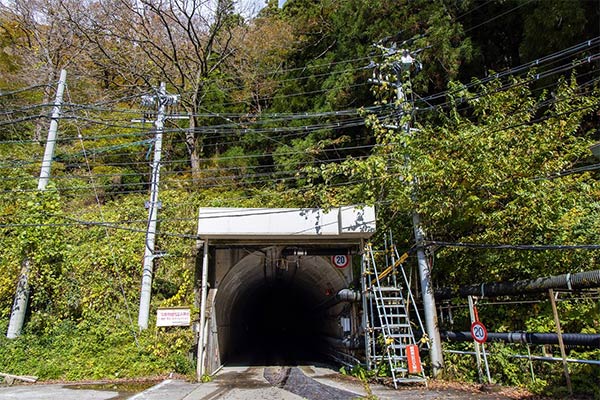
Squinting up at the Universe from an Underground Mine
In late October, the mountainside turns orange and red. The surrounding village, with its many old houses, has a traditional atmosphere. The lush Mount Ikenoyama sits atop a former zinc and lead mine. Travel 1.7 kilometers down the straight, pitch-dark mineshaft and you reach the center of the mountain. In a corner of the dark tunnel, surrounded by cool air, is a door to a world of extreme precision.
On the other side of the door is a large room with a domed ceiling. Below us, the rock had been hewn away to accommodate a cylindrical tank with a radius of 39.3 meters and a depth of 41.4 meters—large enough to accommodate three Giant Buddhas of Kamakura stacked on top of one another. Even the Statue of Liberty would fit inside with only her torch protruding. Despite the large size of the cavern, the hard, gneiss rock means there is no danger of a collapse.
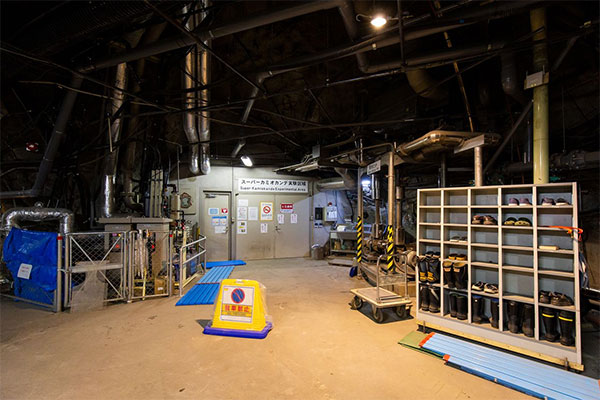
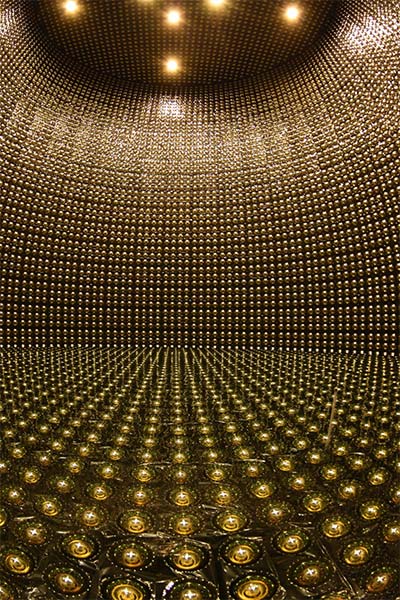
The walls of the tank are covered with 11,129 photomultipliers (light sensors) which look like giant lightbulbs, each 50 centimeters in diameter. Each photomultiplier is so sensitive that it would detect the light from a flashlight on the surface of the moon. The glass bulbs have been carefully shaped by glassblowers and their surfaces coated with gold, giving the walls an ethereal matte gold appearance. (Other than during maintenance, however, the tank is in complete darkness and it therefore not possible to see the array of golden bulbs.)
The tank is filled with approximately 50,000 metric tons of ultrapure water. When, very occasionally, a neutrino reacts with the water, it gives off a cone of bluish Cherenkov light. The array of photomultipliers on the walls of the tank is designed to capture that very faint light.
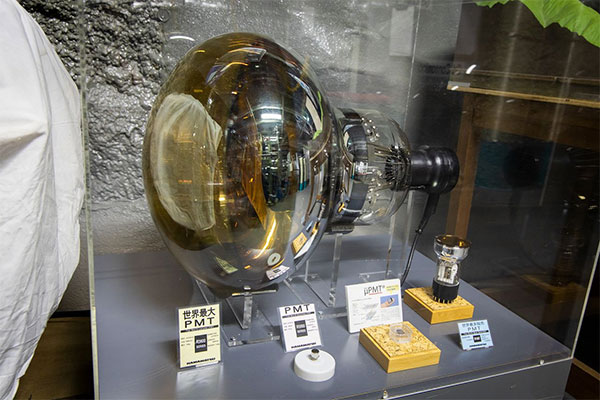
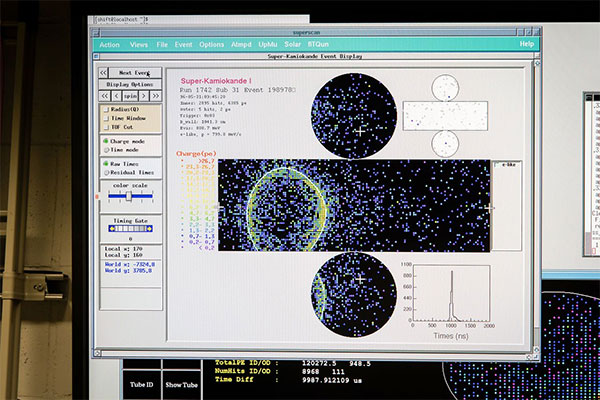
In August 2020, work was performed to dissolve gadolinium (elemental number 64) in the water in the Super Kamiokande tank, bringing its concentration to 0.01% in the fluid, to improve the observatory’s ability to detect neutrinos. The modification means the observatory can now distinguish between the different types of neutrino reactions.
“This enables us to ascertain the direction of a supernova explosion. While the fact that exploding supernovae emit neutrinos was demonstrated by SN 1987A, the supernova whose light reached Earth in 1987, Kamiokande detected a mere 11 of those particles, and US and Russian observatories combined only detected 24. While the addition of gadolinium will not increase the number of neutrinos detected, because we now have 25 times more water—and also because the Milky Way is nearer than the Large Magellanic Cloud, where SN 1987A took place—in the event of a supernova explosion in our own galaxy, we should be able to detect around 10,000 neutrinos with Super Kamiokande. For several hundred of those, we should be able to detect direction as well. This will enable us to understand the location of the supernova.” explains Nakahata.
The improved sensitivity also means that in addition to supernova explosions within the Milky Way, perhaps a few times a year, the observatory may also be able to detect the diffuse supernova neutrino background generated by ancient supernova explosions.
“There are hundreds of quadrillions of heavy stars in the universe that have undergone supernova explosions, meaning that in the history of the universe, there have been many, many explosions. The expansion of space has caused a red shift in the wavelengths of the neutrinos emitted by past explosions. While very diffuse, these particles are still floating around the universe. This is the supernova neutrino background. By capturing these particles, we will be able to tell how large the supernova explosions that created them were, and how long ago they took place,” says Nakahata.
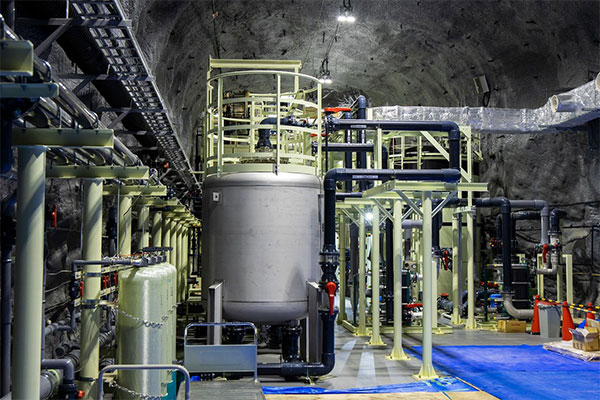
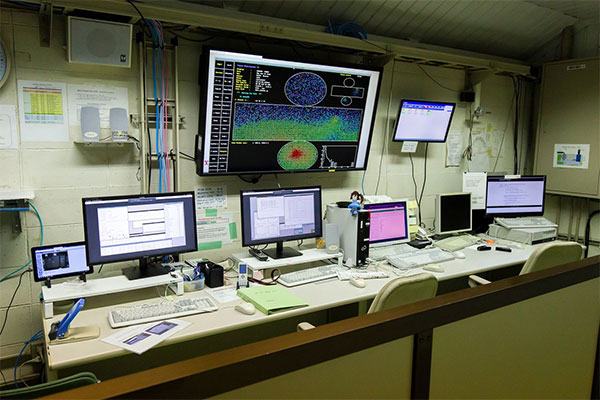
A Field That Sucks You In
I asked Nakahata why he had chosen this field.
Without blinking an eye, he said, “You only have one crack at life, and I decided to take a gamble with someone like Koshiba.”
Nakahata heard about the ambitious and paternal Koshiba when deciding on a field of postgraduate research, Assured by Koshiba that Kamiokande would win a Nobel Prize very soon for findings on proton decay, Nakahata became interested, and he decided to join the project. However, years went by without a single proton decay event being observed.
“I thought I had been played for a sucker at first,” says Nakahata.
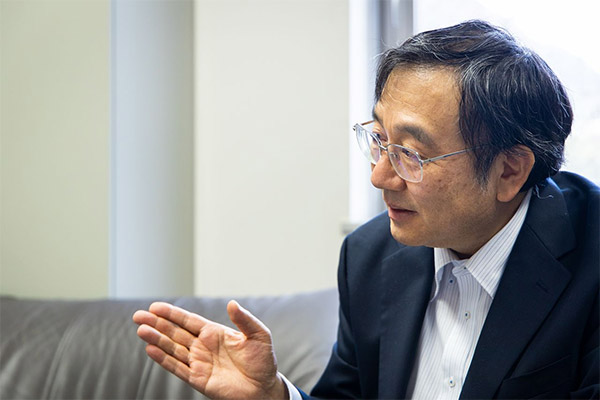
However, it turned out that Koshiba’s real talent was his ability to come up endless new ideas. Deciding that the team should change its focus to neutrino capture, Koshiba modified the observatory accordingly. A mere year later, when neutrinos emitted by the explosion of a supernova in the Large Magellanic Cloud, a nebula near our Milky Way, reached Earth, the team was the first ever to observe neutrinos from outer space.
Nakahata could not help but feel his was a very lucky research group. Supernova explosions are not that frequent. In the Milky Way, where the Earth is located, there is only one such explosion every 30 to 50 years. When you narrow this down to events detectable with the naked eye, it is only one every 400 years. In another lucky coincidence, the first person in the world to obtain the raw data from a supernova explosion was Nakahata himself, followed by a third-year doctoral student charged with data analysis.
“When I discovered those 10 seconds of extremely strong signals in the data at 16:35:35 on February 23, 1987, my heart started racing.”
The event took place just three minutes after a two-minute gap in the data that arose once every two hours while sensors were being recalibrated. If the neutrino collisions had occurred in that blank window, the team would have missed the data. Nakahata says he was very relieved when he saw how close it had been.
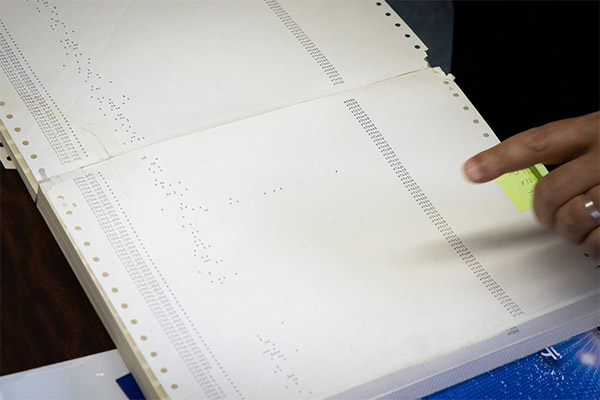
“The thing is, I couldn’t reach Koshiba as he was on holiday at a hot spring in Hakone,” Nakahata laughs. “I guess no one dreamed that this would lead to us winning the Nobel Prize.”
When Nakahata reported the results of his analysis to Koshiba the following week, Koshiba showed no emotion and instead set him another task: “You only have two days of data. I want you to go back and analyze all the other data Kamiokande has recorded and demonstrate that this was the only event.”
Every day for the next week, Nakahata worked late into the night, replaying hundreds of data tapes while also writing his thesis. His results constituted proof of the first-ever detection of neutrinos from a supernova explosion.
Looking back on his career with the Kamiokande and Super Kamiokande, Nakahata says with a smile, “Later we had even more unexpected results, and things got very interesting.”
In 2027, neutrino research will take a step to the next level when Super Kamiokande’s successor, the 260,000 metric ton Hyper Kamiokande, is completed. Researchers will use this facility as they attempt to elucidate a unified theory of elementary particles and the history of the universe.
“Our quest continues. I hope that people will appreciate the excitement and spirit of adventure, and I want more young people to get involved in this field of research,” says Nakahata, an intense light discernible behind his mild gaze.
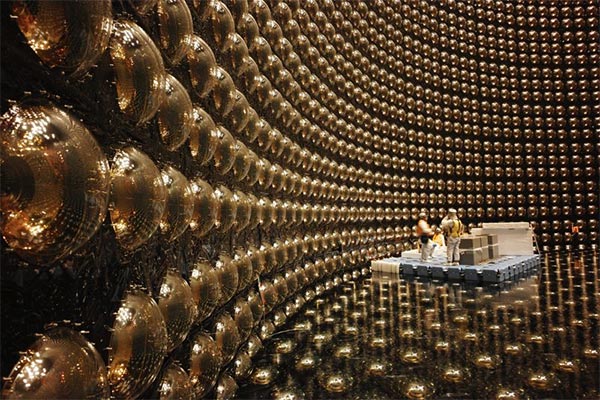
On November 12, 2020, Koshiba Masatoshi, emeritus professor at the University of Tokyo, father of neutrino astronomy, and leader of worldwide research into neutrinos, passed away. He will be remembered for his scientific achievements. May he rest in peace.
Contributed by Nippon.com







